 |
|
Covington Innovations Home > Other Pursuits > Fountain PensA Few Notes about Fountain Pens
|
|
Many links updated September 2009. This page is not kept
continuously up to date, and links may be out of date.
New: Pen-related blog entries
When ink spreads out on the nib of a fountain pen
Review of xFountainPens.com X750
My best pen yet?
Pen with too much ventilation |
Contents:
Why write with a fountain pen?
Repairs and troubleshooting
Some of my pens and their stories
How to fill a Sheaffer Touchdown (plunger) fountain pen
Italic handwriting and calligraphy
Greek lettering
Inks and chromatography
Some interesting pen-related links
Sign seen in the dining hall of Valdosta State University:

Fork, knife, spoon, and fountain pen?
(Thanks to Cathy Covington.)
Why write with a fountain pen?
I use fountain pens for three reasons:(1) Comfort. A fountain pen trains you to write with light pressure and is much less tiring than a ballpoint, rollerball, or pencil.
(2) Legibility. Except for my signature, I no longer use cursive (longhand); my ordinary
handwriting is a simplified form of italic calligraphy.
It is every bit as fast as cursive and much easier to read.

The pen, with an italic (stub) point, helps.
(3) Low cost. Fountain pens need not be expensive, compared to other usable pens. (I exclude disposable ballpoints that require super-hard pressure and produce ugly writing.)
A cheap but serviceable rollerball or ballpoint pen costs at least $2, and you're likely to lose it or have it wander away within a month or two. That means that in two years, you'll spend perhaps $25 on pens. That same $25 will buy you a quite usable fountain pen and enough ink for several years.
Even a high-end fountain pen, allowing $200 for pen, ink, and possible repairs, is cheaper over its useful life (20 to 40 years) than cheap ballpoints. After all, $200 spread over 20 years comes to 19 cents per week.
Repairs and troubleshooting
Fountain pens are repairable! The nib (point) is unlikely to wear out in one person's lifetime. Everything else is fixable. Actually, so is the nib...The definitive guide is Fountain Pens: The Complete Guide to Repair and Restoration, by Frank Dubiel, known to its friends as "da book."
In the meantime, here are a couple of easy repairs:
Cleaning: A pen that is left unused with ink in it for several weeks will probably become clogged. Flushing with water will clear it. In difficult cases, the nib can be soaked in water, but do not soak parts of an old pen that are not normally in contact with ink, because some early plastics are not waterproof. A small amount of ammonia or liquid detergent can be added to the water.
I have also found that highly soluble inks, such as Sheaffer Skrip red, will tend to clean out a pen as you write with it. Every so often I run a cartridge of Sheaffer red through each of my pens.
Increasing ink flow: If ink does not flow freely enough (i.e., you have to press down hard to write), and cleaning doesn't fix the problem, then the tiny gap between the two tines of the nib probably needs widening or unclogging. I've done this several times by carefully inserting a razor blade into it from the tip, then withdrawing it equally carefully. Proceed slowly; a small change, too small to see, is generally enough.
Scratchy pen: First look at the tip under a magnifying glass and see if one of the tines is bent up or down relative to the other; if so, correct it. This is almost always the problem, so be persistent.
If nothing is obviously wrong, you can generally smooth out a pen by writing a few words or sentences on 2000-grit sandpaper, varying the way you hold the pen as you do so. Caution: Go lightly; making just a few figure-8's is enough. This technique can severely wear down a fine-pointed, high-quality nib; use it only on cheaper nibs and those with severe problems. You can polish a high-quality nib by writing on kraft paper, construction paper, or the cardboard backing of a legal pad, and this will not cause harm even if you do a lot of it.
Sac replacement: If you can get to the rubber ink sac easily, you can replace it. (Complex disassembly is best left to an expert.) Sacs are available from The Pen Sac Company. The traditional cement for sealing the sac to the rest of the mechanism is shellac. Do not get wet shellac directly into contact with ink, since wet shellac instantly becomes very gooey upon contact with water. Frank Dubiel recommends clear nail polish or rubber cement.
Making do: A pen that you can't fill (because of a broken sac, unavailable cartridges,
or whatever) can still be used enjoyably as a dip pen.
Some of my pens and their stories
I am primarily a user of fountain pens, and only secondarily a collector. Here are some of my pens (as of 2002; I'm not updating this page every time I get a new pen!). If I've misidentified any of them, I'd be glad to hear from anyone who could set me straight. I have no plans to sell any of these.As you can see, I'm partial to Sheaffer products because I've found them very reliable. I've never worn out the inner parts of a Sheaffer pen, even under conditions of very heavy use (like 5 hours of writing per day for 2 years, enough to put a lot of wear on the barrel). In recent years I've started using Pelikan pens extensively.
Other brands of pens are also well made. Price is not necessarily a good indication of quality; above a certain level the actual reliability of the pen does not increase, and you're paying for decoration, which may great art but may also be quite fragile.
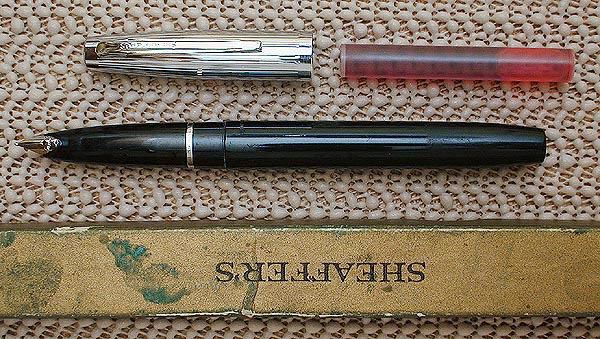
Sheaffer Skripsert cartridge pen
This is a cartridge pen from the early 1960s.
Cartridges became popular in the 1950s and 1960s as ballpoints began to take over
and inkwells were no longer provided in offices and schools.
The pen is still in good working order but I do not use it.
It belonged to my grandmother, Nellie Aaron Covington.
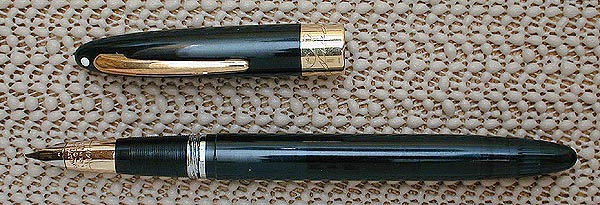
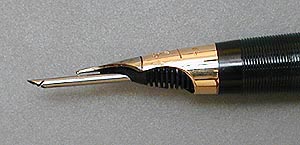
Sheaffer Snorkel
Apparently from the 1950s, this is a Sheaffer "snorkel-filling" pen.
The close-up shows the snorkel extended.
Unlike other fountain pens, this one does not require wiping with
tissue paper after filling.
The rest of the filling mechanism
is the familiar Touchdown system described below.
This pen belonged to my wife's uncle, the late Kelly Lindsey.

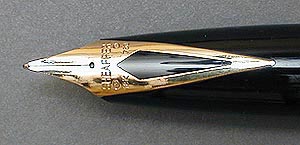
Sheaffer Legacy 2
This pen is my current workhorse, given to me just recently (August 2001) as an
anniversary present by my wife.
It has a medium round nib and uses the Touchdown filling system.
The barrel is palladium, and the whole thing is very massive.
I mused that it's useful not only for writing, but also for beating off attackers,
and my daughter Cathy replied,
"Of course. The pen is mightier than the sword."

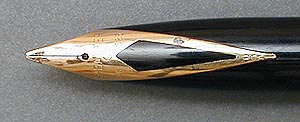
Sheaffer Targa
This is another workhorse, now almost out to pasture.
In 1980 my mother gave me a black Sheaffer Targa pen with a medium nib, to write
my dissertation with — which I accordingly did.
In several hours per day of hard use, the barrel became quite worn, and around 1986
I purchased a much cheaper steel-nibbed Targa and swapped the insides.
That was my most-used pen until July 2001, when I had the misfortune to drop it on
its point, breaking the ball off.
Although it could have been repaired, I chose to grind the nib straight to make an italic
point.
This is now a very good italic pen, but semi-retired.


Sheaffer Triumph
This is probably my most-used pen of all time.
I bought it in 1976 in Oxford, England
(for a whopping £8), and the nib was replaced, due to an ink feed problem,
under warranty in 1977 in Cambridge.
The barrel and cap became severely worn in a few years, and today it has the barrel of
a different pen and the cap of yet another one.
(Like the mythical beast that has "the body of a lion and the head of a lion, but not the
same lion"!)
I continue to use it almost daily.
This is a genuine Sheaffer italic nib, made in the U.S.A. but marketed only in Europe, as
far as I can determine.


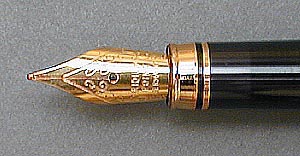
Hand-crafted wooden pens
These are hand-crafted wooden fountain pens made by my wife's father,
Jim Mauldin (of Winder, Ga.; formerly www.pensandmore.org; he retired from pen-making
in August 2009).
They have round iridium points and take international cartridges as well as
piston converters.
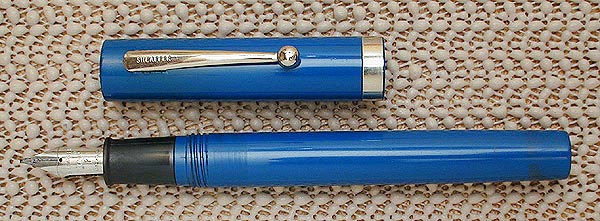
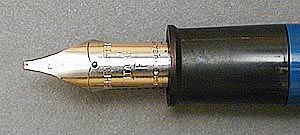
Sheaffer Calligraphy Pen
This reliable, inexpensive pen is the easiest way to get started learning italic
calligraphy; full instructions come with it. It takes Sheaffer cartridges and
can also (usually) take a Sheaffer squeeze converter for filling from an ink bottle.
I've found it considerably more reliable than competing
low-priced calligraphy pens from Platignum, Osmiroid, and Speedball.
Use the Fine nib for handwriting, the broader ones for large lettering.
How to fill a Sheaffer Touchdown (plunger) fountain pen
The workings of this pen tend to be somewhat mysterious because it fills on (or rather right after) the downstroke, and it's not obvious how a pen could do that. The most common mistake is to withdraw the pen from the ink before it has finished filling.

Note: The instructions that came with my Legacy 2 pen recommend doing this twice
with the nib immersed in the ink.
Italic handwriting and calligraphy
An italic pen is one whose point is not a ball, but rather is cut straight across so that the width of the line depends on the direction in which it is moving. That is the way quills were trimmed in the Middle Ages.Later, quill pens and steel pens had sharp points that would spread apart under heavy pressure, so that the width of the line depended on the pressure. That is the type of pen used for Spencerian or copperplate writing.
Italic pens were revived by William Morris in the 1870s and by Alfred Fairbank in the 1930s.
I learned italic handwriting in 1973 from this chart, which came with a Platignum italic pen:
See also the free charts published on the Web by Speedball.
As far as I can determine, Platignum is out of business, though I'd be glad to hear otherwise. Inexpensive italic ("calligraphy") fountain pens are marketed by Sheaffer, Panache, and Manuscript, among others. The C series of Speedball dip pens correspond to italic fountain pens.
You can make an italic point out of an ordinary fountain pen by snipping off the ball and grinding the point smooth on a grindstone or very fine (1500 grit) sandpaper.
"Left oblique" nibs are made for left-handers, and also for right-handed people doing calligraphy in Devanagari or Arabic.
My italic handwriting is not calligraphy, though when I want to, I can slow down and produce something that almost passes for calligraphy. The purpose of handwriting is to be legible and fast. I find I can do italic handwriting as fast as most people can do cursive, and the results are far more legible.
Italic is particularly suitable for teaching in elementary school because there is an easy transition from manuscript to cursive — you can join the letters, or not, as you prefer. The Society for Italic Handwriting promotes its use, especially in schools.
There's not much on the Web about italic lettering. Here are some useful books:
Calligraphy Made Easy, by Margaret Shepherd (good for beginners, although some experts wish it were fancier)
Speedball Textbook (all types of lettering)
Italic Letters: Calligraphy and Handwriting, by Inga Dubay and Barbara Getty
Italic Handwriting, by Tom Gourdie (out of print, still occasionally available)
A Handwriting Manual, by Alfred Fairbank (out of print, still occasionally available)
Greek lettering
While learning Greek many years ago, I adapted italic handwriting to the Greek alphabet in order to write Greek quickly and legibly.My experience, learning several languages, has been that as long as you are "drawing" letters in an inconsistent way, you'll have trouble remembering what you've written. It is important, as early as possible, to equate each letter with a specific set of muscle movements that you can perform without conscious analysis.
Here's a chart of what I came up with. Teachers and students of the Greek language are encouraged to use it. Commercial republication requires my permission.
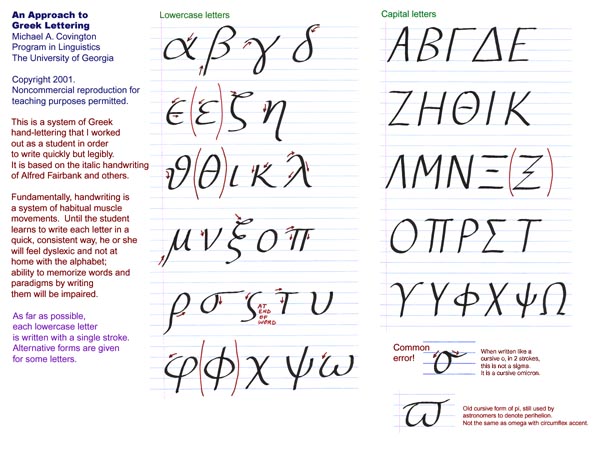
Click to enlarge
Click here for printable PDF version
Some of the letters can be made with a stroke in the opposite direction than I indicated.
This is handwriting, not calligraphy, but a skilled calligrapher (which I am not) could easily use it as the basis for beautiful work.
For a similar approach to Hebrew lettering I strongly recommend
A Guide to Hebrew Lettering, by Peretz Prusan,
unfortunately out of print but still available secondhand.
Inks and chromatography
Not all inks are fountain pen inks. In particular, drawing ink or India ink designed for dip pens or drafting pens should not be used in fountain pens, since it will clog then pen and its residue cannot be removed.Fountain pen inks consist of water, one or more soluble dyes, and a small amount of a wetting agent (detergent) both to clean the pen and to help the ink adhere to paper that may be slightly oily.
For more than 75 years, virtually all fountain pen inks have been based on soluble aniline dyes. Sheaffer Skrip "writing fluid, the successor to ink" was one of the first brands to prominently advertise the fact that it is soluble and noncorrosive.
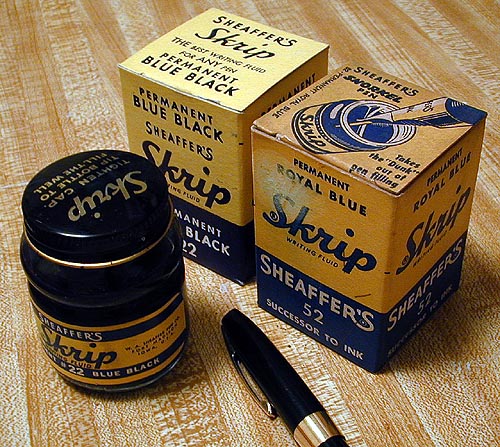
Iron gallotannate inks remained on the market into the early 20th Century. These inks are relatively light-colored when first applied, and then they blacken the paper gradually over a period of several days, sometimes corroding both the paper and the pen. They were normally supplied with a blue dye in them, so that they went on blue and turned black — "Carter's Blue-Black Writing Fluid."
Whether ink is "permanent" is a matter of degree. Permanence includes (1) a tendency to bind much more tightly to paper fibers than to water, so that it can't be washed out; (2) resistance to the fading effects of light.
I have found that Sheaffer Red is one of the most permanent inks, and Sheaffer Blue, one of the most washable. Inks toward the washable end of the spectrum do not work well with paper that is slightly oily, such as index cards carried in a pocket. More "permanent" inks go on such paper more easily.
Most inks become more permanent (i.e., less washable) after several days of drying and curing. I have noticed this particularly with black Parker Quink.
One simple way to learn something about ink is to analyze it by chromatography. Make a line near the edge of a piece of filter paper (a coffee filter will do); hang the paper above a container, with the line at the bottom; and fill the container with water just to the bottom of the paper, below the line. As the water travels up the paper by capillary action, it will separate the ink into its component dyes.


The second picture above is a chromatogram of (left to right) Sheaffer blue, Mont Blanc black, and Parker Quink black. It shows clearly that the Parker ink uses a single black dye (yes, soluble black dyes exist) while the Mont Blanc ink is a mixture of colored dyes.
Pelikan Royal Blue (Königsblau) ink tends to fade slowly
as it dries on some kinds of paper.
The culprit appears to be pH.
Alkaline substances make this ink fade.
Unfortunately, we want our paper to be alkaline in order to keep well.
Other blue inks are not affected.
Some interesting pen-related links
There are a lot of pens on the Web! Here are a few links that will lead you to many others. (Note: Broken links are common here. I cannot guarantee that all of these will work at any particular time.)
Information pages
Fountain Pen Network (forums!)
Penoply (Rick Conner)
Evan Lindquist's ink pages
These will lead you to many more good sites.
Pen and ink manufacturers
Sheaffer
Pelikan
Mont Blanc
Private Reserve Ink
Major dealers
xFountainPens.com (economical, reliable imported pens)
Artlite (Atlanta) (where I shop)
Fountain Pen Hospital (New York)
Fahrney's Pens (Washington, D.C.)
The Pen Company (UK, sells worldwide)
Fountain Pen Emporium (UK, sells worldwide)
His Nibs
World Pen
Pendemonium
Swisher Pens
Santa Fe Pens (nice store in Santa Fe, N.M.)
City Organiser (major British store)
Ink Palette (ink and cartridges of all types)
U.S. pen shop locator courtesy of Private Reserve Ink
Fountain pens on eBay (U.S.A.) (caveat emptor!)
Fountain pens on eBay (British) (your U.S. account works just fine here)
Specialty items:
Nibs.com — Rebuilding and sculpting of nibs
Tryphon — pen parts and repair tools
Replacement rubber ink sacs at Pendemonium
Corporate Gift Pens customized
with your emblem or logo
Calligraphy
Calligraphy Centre
Calligraphy mailing list
Calligraphy web ring


